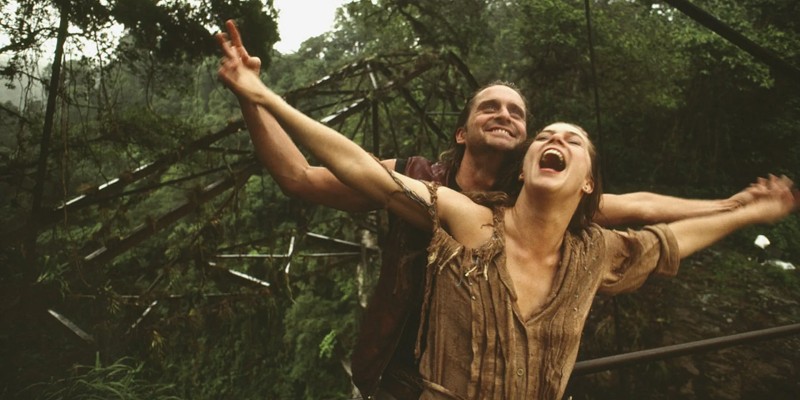The early 1980s were a crazy time for adventure movies. “Raiders of the Lost Ark” had come out in the summer of 1981 and was a huge box-office success, spawning sequels that would continue more than 40 years later and imitators that adapted old adventure tropes like “King Solomon’s Mines” in 1985 and “High Road to China” in 1983, the latter starring the man who might have been Indiana Jones if not for prior commitments, Tom Selleck.
So it’s interesting that the best of the Indiana Jones follow-ups spun the story in a direction that was infrequently explored: what better plot than one revolving around a writer, and what better way to thrust a writer into action than thrusting them into one of their own stories?
Released in 1984, “Romancing the Stone” beat by decades latter-day “authors in their own adventures” films like “The Lost City” and “Argylle.” “Romancing the Stone” – and its lesser-and-lesser-remembered sequel, “The Jewel of the Nile,” from 1985 – got there first, by decades. “Romancing the Stone” really perfected the formula.
And – tragically – it is the fate of the film’s novice screenwriter, Diane Thomas, that is the strangest story connected to the film.
Mudslides and arduous filming
It’s honestly debatable how much “Raiders” influenced “Romancing the Stone” because both were in the works, at least in pre-production, years before Steven Spielberg’s “Raiders” came out.
As early as May 1978, newspaper accounts noted that Spielberg and friend and “Star Wars” creator George Lucas were working on a project called “Raiders of the Lost Ark.” A California paper cited it as a project about which little was known.
Then in September 1979, the Los Angeles Times published a profile of Diane Thomas, not long after she had been working as a waitress and after she had spent a year writing “Romancing the Stone,” “which neither she nor (producer and star Michael) Douglas nor her agent will say much about. The fear, as with many film ideas, is that someone will steal the idea and turn it into a quickie TV movie or low-budget feature.”
“I’ll never sell my first screenplay again,” the 33-year-old Thomas is quoted as saying. “I know this is a Cinderella story, although I don’t have any glass slippers around my house. Maybe I should get a pair.”
Thomas could afford them. She had famously been paid $250,000 for the screenplay for “Romancing.”
The headline on the Times article: “A New Career with a Cinderella Ending.”
“Romancing the Stone,” in the meantime, wouldn’t be released until the end of March 1984, when the competition at the box office included “Footloose,” “Splash,” “Against all Odds” and “Police Academy.” Even in April, the first full month “Romancing” was in release, it came in second in terms of tickets sold to “Police Academy.”
It seemed like the immediate payoff was not there. After all, star and producer Michael Douglas had been working on the film for five years, nurturing Thomas’ script. And production in Mexico was arduous.
“I had really underestimated the logistics of shooting a chase picture in the middle of the jungle in monsoon season in a foreign county,” Douglas said in an interview published in the Philadelphia Inquirer. “We were flying without a net a lot of the time. We were out on the edge.”
While the movie probably got made through Douglas’ perseverance, it was director Robert Zemeckis who pulled off the film. Zemeckis had made two films before making “Romancing the Stone.” He was not yet the seasoned director who would later make “Back to the Future” and two sequels, “Who Framed Roger Rabbit,” “Forrest Gump,” “Castaway” and other, lesser films.
Among Zemeckis, Douglas and Thomas, “Romancing” boasted memorable scenes, probably none as memorable as the mudslide scene, in which the leads slide down a steep hillside in the rain and mud.
Douglas and Zemickis assembled a small but tight cast. Douglas played reluctant adventurer Jack Colton, but the standout was Kathleen Turner – who had a sensational debut in 1981 with “Body Heat” – playing successful romantic adventure novelist Joan Wilder. She’s a homebody – she has a cat, for goodness sakes, as if “Argylle” couldn’t find enough other plot points to cop – who goes to Colombia to help her sister and in the adventure becomes more confident, a woman able to stand up to gangsters and secret police and crocodiles. It’s not quite one of those woman-takes-her-glasses-off-and-is-a-beauty clichés, but Joan does reveal the beauty that is Turner.
Other cast members include Danny DeVito as a small-time hood who helps to move the plot along and while the movie isn’t as dated as I was afraid it would be, there’s not the kind of depth of character that we’d see in a movie like this today.
“Romancing the Stone” was a hit, though, grossing $115 million and Zemickis said the movie’s success ensured he could direct “Back to the Future.”
But Diane Thomas, the screenwriter of “Romancing the Stone,” did not have the Cinderella-like ending the Los Angeles Times had wished for her back in 1979.
Listening ‘while Diane saved the world’
After she wrote “Romancing the Stone,” Thomas co-wrote the Spielberg film “Always,” a romantic fantasy starring Richard Dreyfuss.
She also finished a draft of a third Indiana Jones movie, which reportedly revolved around a haunted house. By some accounts, Spielberg decided against going forward with the idea because it reminded him too much of “Poltergeist,” which he had produced in 1982.
In October 1985, Thomas died instantly when her Porsche Carrera, which was being driven by her boyfriend, spun out of control while traveling at speeds approaching 80 miles per hour on the Pacific Coast Highway. Thomas had been sitting in the backseat of the sportscar. Another passenger died of injuries from the crash.
Thomas died six weeks before the “Romancing” sequel, “Jewel of the Nile,” was released. Aside from a few characters she worked on for Douglas, Thomas had not been able to pen the script for the sequel because she was busy with her work on “Always.” She is one of three writers credited with the script for “Jewel of the Nile.”
A few weeks after her death, Betty Spence wrote about Thomas for the Los Angeles Times and the remembrance paints a picture of every writer ever – or at least who they’d like to be – and every writer who’s ever written themselves into their own story.
“She worked relentlessly, with a discipline that amazed us. Her habitual eight hours at the typewriter might result in a dozen pages or only two, yet she persisted, even when writing on spec. One night before her movie was made, she showed her day’s output: a list of five neatly typed ideas. Eight hours’ thinking.
“Wine glass in hand, legs akimbo on the couch, she pitched one to me, her dreamer’s mind unleashed as she unraveled an original saga of a girl with the secret of the philosopher’s stone. In awe, I listened while Diane saved the world as naturally as she might recount her own history.”

















